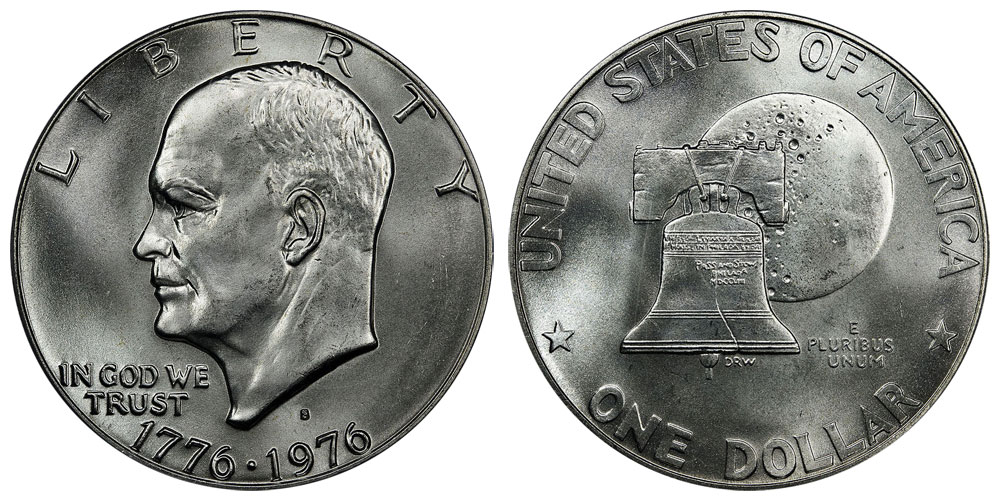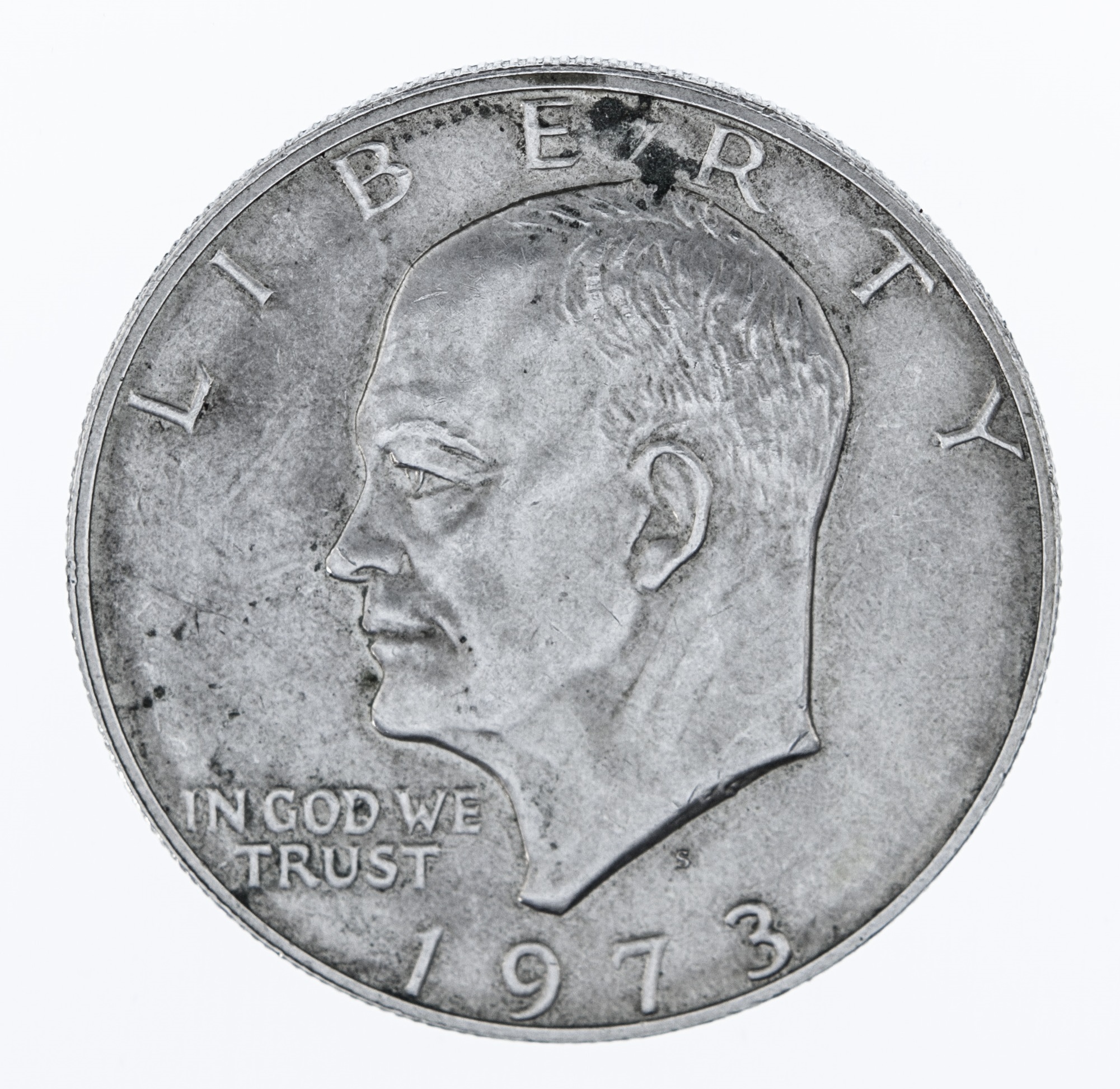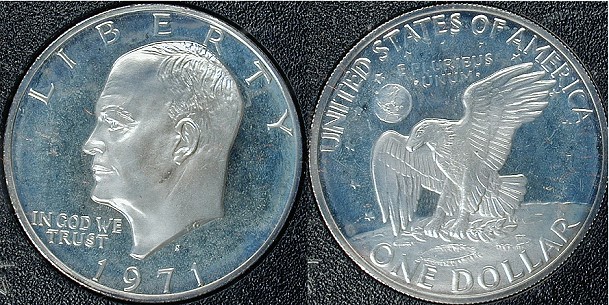Eisenhower Silver Dollar Values & Price Chart
The Eisenhower dollar, sometimes also called the Bicentennial dollar, was struck from 1971 through 1978 and was intended for regular commerce. Ultimately it failed to see the light of day as a circulating coin beyond the casinos of Las Vegas.
Read below for a full list of Eisenhower dollar prices.
Few people knew back in the 1970s that the Eisenhower dollar would be the last circulating large-size dollar coin in the United States.
Today, it's become one of the top modern collectible coins, and for good reason. Ike dollars constitute a relatively short series with many unusual varieties to collect.
Like Ike? Plenty of coin collectors do! A growing number of numismatists are building sets of Eisenhower dollars.
What Are Eisenhower Dollars Worth?
Eisenhower dollars appeal to collectors on a variety of budgets. Many pieces challenge even financially well-heeled collectors. Prices for some key date Ike dollars reach into the thousands of dollars.
Nonetheless, the majority of Eisenhower dollars are much more affordable to obtain. What follows is an Eisenhower dollar price guide. The values reflect examples in MS-63 (uncirculated) and Proof-65 grades.
Eisenhower Dollar Price Chart
| Date | Composition & Finish | Price |
|---|---|---|
| 1971 | Copper-Nickel Clad Uncirculated | $4 |
| 1971-D | Copper-Nickel Clad Uncirculated | $3.50 |
| 1971-S | 40% Silver Clad Uncirculated | $10 |
| 1971-S | 40% Silver Clad Proof | $11 |
| 1972 | Copper-Nickel Clad Uncirculated | $3.50 |
| 1972-D | Copper-Nickel Clad Uncirculated | $3.50 |
| 1972-S | 40% Silver Clad Uncirculated | $10 |
| 1972-S | 40% Silver Clad Proof | $11 |
| 1973 | Copper-Nickel Clad Uncirculated | $10 |
| 1973-D | Copper-Nickel Clad Uncirculated | $10 |
| 1973-S | Copper-Nickel Clad Proof | $11 |
| 1973-S | 40% Silver Clad Uncirculated | $11 |
| 1973-S | 40% Silver Clad Proof | $30 |
| 1974 | Copper-Nickel Clad Uncirculated | $4.50 |
| 1974-D | Copper-Nickel Clad Uncirculated | $4.50 |
| 1974-S | Copper-Nickel Clad Proof | $5 |
| 1974-S | 40% Silver Clad Uncirculated | $11 |
| 1974-S | 40% Silver Clad Proof | $13 |
| 1776–1976 | Copper-Nickel Clad Variety I (Thick Reverse Letting) Uncirculated | $6 |
| 1776–1976 | Copper-Nickel Clad Variety II (Serifed Lettering) Uncirculated | $3.50 |
| 1776–1976-D | Copper-Nickel Clad Variety I Uncirculated | $3.50 |
| 1776–1976-D | Copper-Nickel Clad Variety II Uncirculated | $3.50 |
| 1776–1976-S | Copper-Nickel Clad Variety I Proof | $8 |
| 1776–1976-S | Copper-Nickel Clad Variety II Proof | $6 |
| 1776–1976-S | Silver Clad Variety I Uncirculated | $14 |
| 1776–1976-S | Silver Clad Variety I Proof | $17 |
| 1977 | Copper-Nickel Clad Uncirculated | $3.50 |
| 1977-D | Copper-Nickel Clad Uncirculated | $3.50 |
| 1977-S | Copper-Nickel Clad Proof | $4 |
| 1978 | Copper-Nickel Clad Uncirculated | $3.75 |
| 1978-D | Copper-Nickel Clad Uncirculated | $3.50 |
| 1978-S | Copper-Nickel Clad Proof | $4 |
All the values listed above represent typical specimens. These have regular surface quality for their respective grades and conditions.
Better pieces command significantly higher premiums than the prices listed above. This is due to the difficulty of locating Eisenhower dollars (mainly clad business strikes) with few contact marks.
1978 Silver Dollar Value: Mistaken Identity
1978 marked the last Eisenhower dollars struck by the United States Mint.
Following the Morgan dollar and Peace dollar series, it's true that the Eisenhower dollar series was the last U.S. dollar coin containing silver until the introduction of the American Silver Eagle, a whole new kind of silver dollar coin, in 1986.
The concept of a 1978 silver dollar is a misconception, however. Although 40% silver Eisenhower dollars were still made for the Bicentennial versions of the coin (with a special Bicentennial design and the date "1776–1976"), all of the dollar coins dated 1977 and 1978 are copper-nickel clad. In other words, there is no silver content whatsoever in their composition, no matter what kind of finish or mintmark they have.
Quickly revising the portion of the price chart covering 1978, you'll see that prices are in line with the most common Ike dollars.
| Date | Composition & Finish | Price |
|---|---|---|
| 1978 | Copper-Nickel Clad Uncirculated | $3.75 |
| 1978-D | Copper-Nickel Clad Uncirculated | $3.50 |
| 1978-S | Copper-Nickel Clad Proof | $4 |
You can shop for silver dollars at Gainesville Coins by following the link.
How the Eisenhower Dollar Was Created
United States Mint Chief Engraver Frank Gasparro created the coin's obverse design depicting President Dwight D. Eisenhower. (Gasparro also was the reverse designer of the Kennedy half dollar.) The reverse design shows an eagle landing on the moon carrying an olive branch, the artist's take on the official insignia of the Apollo 11 mission. The first Eisenhower dollars were new coins struck in 1971.
Cupro-nickel clad versions were produced at the Philadelphia Mint and Denver Mint for circulation. Meanwhile, 40% silver examples were made at the San Francisco Mint as proofs for collectors.
Copper-nickel S-mint proof versions didn't come around until 1973. This was the first year that regular uncirculated mint sets and proof sets included the Eisenhower dollar.
The cupro-nickel coins have a gross weight of 22.68 grams. Their silver counterparts (made of 60% copper) weigh in at 24.59 grams, with 0.3161 troy oz of pure silver metal content. All Eisenhower dollars measure 38.1 mm in diameter and bear a face value of $1.

Image source: USA CoinBook
In 1975, the U.S. Mint began producing special commemorative circulating Eisenhower dollars honoring the 200th anniversary of the signing of the Declaration of Independence—the nation's bicentennial celebration.
These Bicentennial dollars showcase a dual-dating feature declaring 1776–1976 on the obverse design. The reverse design by Dennis Williams features the Liberty Bell superimposed on the Moon.
The standard Eisenhower dollar reverse and obverse dating resumed in 1977. Yet the end was in sight for the coin in 1978.
The public deemed the Eisenhower dollar too large. Americans were unwilling to carry large numbers of the heavy dollar coins during a period of runaway inflation.

40% Silver Eisenhower Dollar
The large dollar coin had failed to circulate well and was thus retired before 1979. This was when the Susan B. Anthony dollar, also designed by Gasparro, entered circulation.
However, the Susan B. Anthony dollar never caught on with the public, either. It was retired shortly after that in 1981. It returned for a one-year stint a general later in 1999 before being put out to numismatic pasture for good.
Collecting Eisenhower Dollars
The vast majority of hobbyists who collect Eisenhower dollars aim to complete a 32-coin set. It consists of all the regular-issue business-strike and proof coins. This includes the 40% silver Ikes dated 1971-S, 1972-S, 1973-S, 1974-S, and 1976-S.
![Percentage of Silver Eisenhower Dollars [graph] percentage-silver-ikes](https://cdn-img.gainesvillecoins.com/blog/2019/07/ikes.jpg)
Tricky Ikes: Only a small percentage of the total Eisenhower dollar mintage is 40% silver. Image source: Reddit user rddt1983
Such a set can be completed with coins in typical uncirculated and proof grades for less than $500. That includes the 40% silver key dates mentioned above, which are worth much more than their melt value.
You may hear people refer to "Blue Ikes" and "Brown Ikes" in coin collecting circles. This comes from the fact that the U.S. Mint originally sold uncirculated Eisenhower dollars in blue envelopes, and sold the proof Eisenhower dollars in wooden brown boxes. Hence the nicknames.
Collectors with deeper pockets will add a much more expensive dimension to their Ike dollar objectives. They often pursue each of the regular-issue clad coins in Gem grades. When it comes to grading coins, they target proofs that grade Proof-67 or higher. Many will also seek the abundance of scarce varieties known for this series.

1971-S Silver Proof Eisenhower Dollar
Surprisingly, clad business strikes in grades of MS-65 to MS-66 or better are among the most valuable Eisenhower dollars. There are few such Ikes that grade MS-68 or better.
The United States Mint took little care in handling or transporting these large, heavy circulating dollar coins. Many of them now have contact marks. Understanding this, it becomes clearer why clad Ikes in Gem condition (Uncirculated condition) are so tough to locate. Most of the rarest Gem examples trade for more than $1,000 today.
Eisenhower Proofs
Top-end proofs are not nearly as rare as their high-grade clad business-strike counterparts. Certain dates are tough to find with full cameo frosting, however. The 40% silver Ikes are among the easiest examples to find in grades of Proof-69 or Proof-70.
Meanwhile, deep cameo contrast is most common on the 1977-S and 1978-S Eisenhower dollars. This originated from a period when deep cameo frosting was becoming more the norm rather than the exception for U.S. proof coinage.
Many other commemorative coins made by the U.S. Mint, like the one featuring President Eisenhower below, are likewise made in proof finish in addition to Brilliant Uncirculated.
1972 Eisenhower Variety

Image: USA CoinBook
The Eisenhower dollar boasts a wide array of varieties. Those who collect design varieties have plenty to love.
The most popular varieties are found among 1972 Ikes. It showcases at least three different versions of planet Earth on the reverse design. They are usually called 1972 Type 1, 1972 Type 2, and 1972 Type 3 by coin dealers and collectors of modern coins.
Type I is a relatively low-relief variety showing three islands to the right of Florida.
Type II, the scarcest of these three varieties, shows no islands below Florida. (Water lines are in their place instead.)
Type III shows three islands below and to the left of Florida.
Clearly, there are some geography issues at hand with these varieties. They keep collectors busy!
Several other exciting oddities are out there. This includes various doubled dies and the rare 1974-D and 1977-D 40% silver transitional wrong-metal strikes.
There are numerous avenues in the Eisenhower dollar series that one can take. So many collectors have devoted their entire numismatic careers just to the Eisenhower dollar.
These modern clad coins offer a multitude of rewarding opportunities for collecting, research, and discovery—enough to satisfy even the most passionate of dedicated collectors for a lifetime!
If you would like to sell coins at a great price, click the link or give us a call at (813) 482-9300 at Gainesville Coins!
Joshua McMorrow-Hernandez is a journalist, editor, and blogger who has won multiple awards from the Numismatic Literary Guild. He has also authored numerous books, including works profiling the history of the United States Mint and United States coinage.
More recent posts about valuable coins from the author:
How Much Is a Silver Dollar Worth? Most Valuable Silver Dollars
Susan B. Anthony Dollars: Values and Series Rundown
Key Date Morgan Silver Dollars: Collecting Tips and Prices
Wheat Penny Lincoln Cents (1909–1958): Coin Values and Key Dates
Washington Quarter: Key Dates and Varieties
Buffalo Nickel Values and History
Simple List of 4 Rare State Quarters Worth Money
Paper Money: What Is a Silver Certificate?
